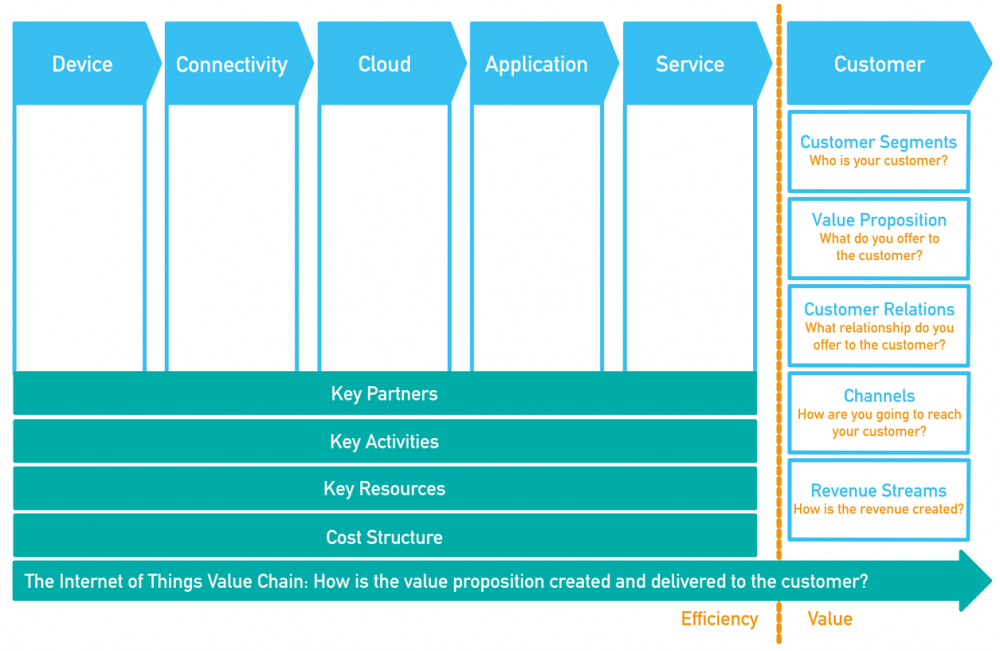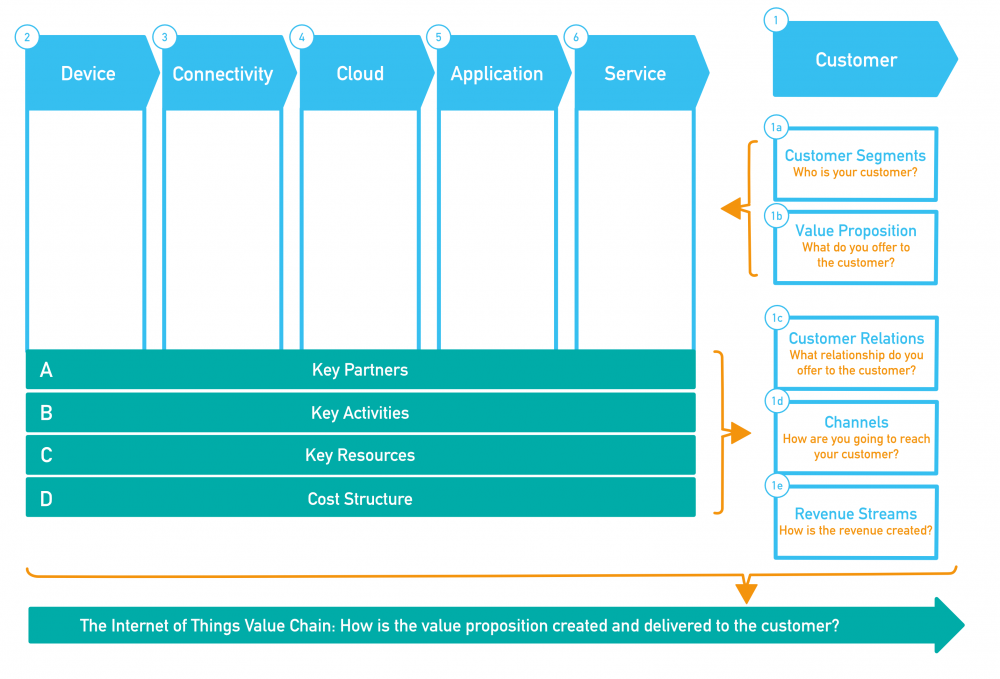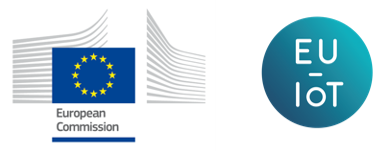
May 11, 2018
Before you start
This learning module is part of the building block:
The module - in brief
The IoT Business Model Innovation Tool (IoT BMIT) can assist in mapping and designing business models using the Internet of Things as a key technology enabler. Thus, the tool represents the outside-in perspective on developing new solutions and services with a focus on customer needs, while it also embodies the integral aspects of the technology into the business model.
The IoT Business Model Innovation Tool
The IoT BMIT is also a tool with a special focus on reducing risk and resource consumption in the development of your company’s business model by ensuring, already in the start-up phase, that 1) a solution, service or business case can be built around the technology you develop and/or deploy, and 2) there are customers or users for the solution or service. The mapping is an alternative to the classic business plan, as the idea behind it is that it can be completed quickly and condensed to one page to create an overview of the business model.
In this presentation of the tool, our starting point is the scenario that we want to capture the transitional move from one business model to a new digital business model containing a solution for a selected customer segment.

Adopted from “The IoT Business Model Innovation Tool” by Mansour & Presser (2018) reproduced by agreement with the authors.
The IoT BMIT applies the two most commonly known business model innovation frameworks today, namely the Business Model Canvas by Osterwalder et al. (2010) and St. Gallen Business Model Navigator by Gassmann et al. (2013), to define the nine known elements of a business model: Customer Segments, Value Proposition, Customer Relationships, Channels, Revenue Streams, Key Partners, Key Activities, Key Resources and Cost Structure. In combination with these elements, the tool integrates the core layers of an IoT architecture:
- The device layer refers to the digital parts that sit on the physical thing. This layer mainly consists of four subcomponents: the sensor module, the power supply, the communication module and the microcontroller.
- The connectivity layer refers to the protocols that facilitate the communication between the device and the cloud.
- The cloud layer is where the data are handled, processed and stored.
- The application layer describes the application that the system is supporting, including its various software components and user interfaces.
A new dimension is added to the IoT architecture in terms of a service layer. It is not directly related to the technical development but is a vital factor for sustainable post-deployment.
- The service layer refers to activities that are related to maintaining the IoT devices, connectivity and cloud as well as helping overall operational efficiency.
The right-hand side of the IoT BMIT maps the “value” of a business model, i.e., who are the value recipients, what is the value proposition, and why is the business model eligible for profit (based on the value proposition, and the delivery of it, to the customers)? The left-hand side of the IoT BMIT maps the “efficiency” of a business model, i.e., how the value is created.
Mapping a new digital business model
Going through the elements of the IoT BMIT will initially help you promote a wealth of ideas for the new digital business model of your company, while it also helps you to gain an overview and quickly discard useless ideas.
The mapping will facilitate a deeper understanding of the technology in the business model innovation process. This is essential for a digital business model to succeed, along with several other abilities, which a mapping with the IoT BMIT supports:
- It connects IoT architecture layers to the elements of the business model. For example, the tool helps to map the IoT architecture to your ecosystem actors and revenue streams and helps to identify strengths and weaknesses regarding the coupling of technology choices in different layers, their interoperability and switching costs.
- It takes on an ecosystem perspective that facilitates a network-centric business model approach. In the IoT domain, it is recommended to avoid a business-centric business model approach and instead maintain value for everyone in the ecosystem as this will lead to stability, sustainability and competitive advantage.
- It identifies various value flows that occur across hardware and software collaborators, and aids you to extract and capture those value flows to generate more revenue streams. Such value flows might include revenue streams, costs as well as tangible and intangible assets.
The IoT BMIT has broad applicability. The tool can be used to design a new digital business model as well as to map an existing digital business model. Hence, it captures innovation as a transitional move from one business model to another, as a starting point for building a business model on top of technology, and as an instrument to further optimise a digitally empowered business model.
Practical information
Set aside 2 hours for mapping and description of the business model elements.
It will be a great advantage to involve key employees from the company’s various departments in this mapping. Firstly, because different people bring different ideas and points into play. Secondly, because employees in different job functions will create a more detailed and complete mapping, and last but not least because the business model innovation process itself is an excellent way to create a common understanding of the potential changes the company is about to go through as well as why and how.
You will need a printed version of the tool the IoT Business Model Innovation Tool, a lot of self-adhesive paper slips (Post-its) and pens (one for each participant). In principle, the results of the mapping can be written directly into a blank document on a computer, but it is highly recommended to perform it physically on paper, as it is much more flexible and makes it easier to stay focused.
Together with the step-by-step guide, the below illustration and video takes you through the elements of the IoT BMIT and offers the support needed to map out the tool.

Adopted from “The IoT Business Model Innovation Tool” by Mansour & Presser (2018) reproduced by agreement with the authors.
In the video below, Mirko Presser, Associate Professor at the Department of Business Development and Technology, Aarhus University, presents the various elements of the IoT Business Model Innovation Tool, as well as how the tool can be used for designing a new business model while visualising the IoT value chain. (UK texts can be activated).
"Presenting the IoT Business Model Innovation Tool". Adopted from Mansour & Presser (2018) reproduced by agreement with the authors and available under licensen CC BY-NC-ND. All the 'IoT Business Model Innovation Tool' framework rights reserved to the original owners Mansour & Presser (2018).
Step-by-step guide
As we are already well on our way to mapping the new business model based on the analysis of value design performed in the Service Design module, we can start by inserting the information we have already through our analysis:
1) Initiate your mapping by focusing on the “Customer” elements. With this, you bring your knowledge from the Service Design module into play and can continue the mapping based on your assumptions about the business model.
- 1a – Customer segment: describe the selected target audience of the solution or service that your company offers. This can be further specified and narrowed down to ‘early users’. Early users are the people who need and request the solution the most and who are the most obvious buyers. The early success of the business model is highly dependent on whether you manage to define and effectively target your early users optimally.
- 1b – Value Proposition: describe the value of your offering from the perspective of the customers. The value proposition shall lead to a competitive advantage and therefore implicitly reflect how you defend yourself against your competitors. A unique competitive advantage is difficult to copy or buy and could be insider information, personal authority, a competent team, a large network, patents etc. In other words, you need to identify the proposition that will make you more successful than others in producing, marketing, delivering and monetising the value to your customers.
Now, you have described to whom you want to provide value, and what that value is. You are then ready to proceed with mapping how the value will be created. You do so based on the IoT architecture by mapping the remaining elements of the business model: Key Partners, Key Activities, Key Resources and Cost Structure. With this, you clarify the technical components of your solution and how the architecture of the solution operates in practice.
2) Starting with the “device layer”, you describe the solution in terms of its digitally enabled physical parts. For all hardware subcomponents of the solution, you now consider the business model elements one by one. Hence, on the “device layer”, you may, for example, ask yourself:
- (2A) Key Partners: what strategic collaborative partners are needed to help develop the device and execute related services?
- (2B) Key Activities: what necessary activities are needed to operate the device?
- (2C) Key Resources: what assets are needed to run the device operations effectively?
- (2D) Cost Structure: what costs are associated with developing and using the device? (Here, costs include fixed costs, operational costs and break-even points.
3) Continuing to the “connectivity layer”, you describe the communication protocols that are used for data transmission. (There are many communication protocols available for IoT, for example, LoRaWAN, Sigfox, NB-IoT, GSM, 3G, 4G, 5G etc.). For the connectivity of the solution, you consider the (3A) Key Partners, (3B) Key Activities, (3C) Key Resources and (3D) Cost Structure.
4) Continuing to the “cloud layer”, you describe how the data are handled, processed and stored.
(There are many cloud application service providers on the market; for example, Microsoft Azure, Google Cloud, Amazon Web Services, IBM Bluemix etc.). For the computation to occur in the cloud, you consider the (4A) Key Partners, (4B) Key Activities, (4C) Key Resources and (4D) Cost Structure.
5) Continuing to the “application layer”, you describe how the solution enables users to interact with the data. Be aware that on the application layer, a clash between engineering and business often happens. Whereas the previous layers built up the technology stack based on a clear requirement specification, this layer adds the user interface on top, which should be based on a business case that is verified by the market and that documents the potential and scalability. For the user interface of the solution, you consider the (5A) Key Partners, (5B) Key Activities, (5C) Key Resources and (5D) Cost Structure.
6) Finally, you describe the activities of the “service layer”, which are often related to the operational efficiency of the solution. Such activities could, for example, include reacting to faulty diagnostics such as low signal strength, low battery level, vandalism or anything else leading to disruptions in the operations. A solution provider must consider how these activities should be performed; for example, in-house through service agreements, outsourced to a service provider or left to the customer. This again requires you to consider the (6A) Key Partners, (6B) Key Activities, (6C) Key Resources and (6D) Cost Structure.
7) Now, you return to the remaining “Customer” elements. With the knowledge you now have about how value will be created, you can proceed to describe how the value should be delivered to your customers as well as how you intend to capture value in order to make the business model profitable.
- 1c – Customer Relationships: describe the level of interaction you expect to have with the customers and users of your solution and/or service. These relationships can range from personalized to automated.
- 1d – Channels: describe how you want to design and use your sales and communication channels to reach the customers with your new solution and/or service. This includes channels for the creation of awareness, evaluation, purchasing, delivery and after-sales.
- 1e – Revenue Streams: describe the revenue your company (intends to) generate from the value proposition. This element is linked to the pricing of your solution, which is also essential in defining the brand value of the solution and in capturing the attention of the early users.
8) You now have your business model mapped out in a format that integrates your technology. This mapping provides an overview of the “IoT Value Chain” in your business. You must now convey this overview into a formulation by describing how this business model creates and delivers the value proposition to the customer. This formulation, in combination with your mapping, makes you capable of demonstrating how you use IoT in generating value and making it a viable business.
The business model you outline here will of course have to be thoroughly tested and evaluated several times; therefore, and at this early stage, it is okay to work from ideas and assumptions.
Output
The result will be that you now have an overview of your new digital business model as well as a well-thought-out plan for your innovation process using the IoT as a key enabler. This is very helpful to assist your company in unleashing the potential of your technology and digital business across the different elements of the business model.
Expert Advice
In relation to IoT business models, IoT cybersecurity is also becoming increasingly critical, so see the expert's advice on how you can work consciously with IoT cybersecurity in your IoT business development.
"Continuing your process with business model innovation" by CyPro available under licensen CC BY-NC-ND.
If you need to look more closely at the details of the development of your business model, there is help available in service design and design of a new digital business model.
Regardless of whether you end the process here or continue with the development process, there is an opportunity to go back to the organisational track and assess how you want to prioritise your efforts in relation to IoT cybersecurity.
Additional resources and knowledge
A range of resources exist to support companies in the development of a new digital business model. Common to the available tools is that they aim to provide an idea and an overview of value creation, value delivery and value capture as described in the module What you need to know about digital business models. Such tools offer more simple methods for mapping, designing and testing a new business model than a written report because a better overview promotes opportunities for collaboration and development. Additional tools include, for example:
- Business Model Canvas (Osterwalder et al, 2010)
- The LEAN Canvas (Ash Maurya, 2010)
- DNA-Model (Sun et al, 2012)
- The Business Model Cube (Lindgren & Rasmussen, 2013)
- Gallen Business Model Navigator (Gassmann et al, 2014)
- Value Design Model (Westerlund et al, 2014)
- BM Type for IoT Model (Turber et al, 2014)
- 3DCM Model (Chan, 2015)
Further knowledge on the IoT BMIT and other tools for digital business model innovation can be found in the research publications below:
- Aagaard, M. Presser, M. Beliatis, H. Mansour and S. Nagy. (2018). “A Tool for Internet of Things Digital Business Model Innovation”. IEEE.
- Mansour, M. Presser and T. Bjerrum. (2018). “Comparison of seven business model innovation tools for IoT ecosystems”. IEEE.
Next step
Common to all the elements in your mapping is that they are not fixed and, therefore, can always be changed. There are many opportunities to test, change and iterate as new learnings arise through the process.
Read more about the development process and testing of business models in the modules Early usability testing and prototyping as well as Internal validation and testing.

The contents described above have been developed in the projects:
’CyPro – Cybersecure manufacturing in Denmark’ by Aarhus University, Alexandra Institut, DAMRC, UGLA Insights and FORCE Technology funded by The Danish Industry Foundation. Material from the project is published under Creative Commons.
CyPro
And through the EU-IoT project by Aarhus University, Martel Innovate, Netcompany-Intrasoft, Fortiss, BluSpecs and funded by the Horizon 2020 Framework Programme under topic ID ICT-56-2020, grant ID 956671.
EU-IoT is the European IoT Hub. The EU-IoT project works towards growing a sustainable and comprehensive ecosystem for Next Generation Internet of Things.

You have completed the entire building block
Get your certificate for this completed building block. Request the certificate and we will send you the personal certificate.



